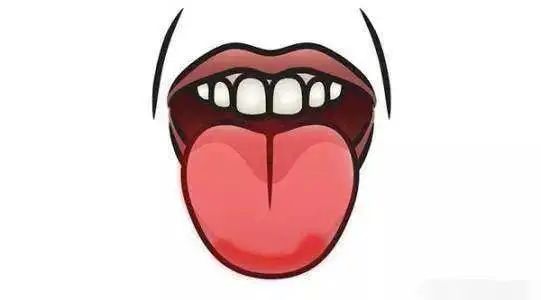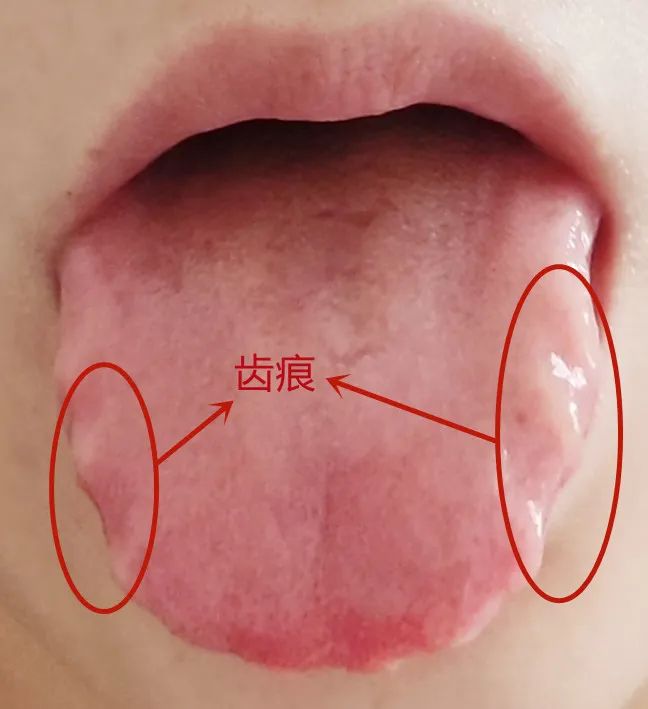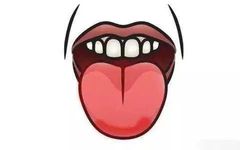
Click the above blue text, to follow us
Tongue diagnosis is one of the key components of observation in Traditional Chinese Medicine (TCM)。
The diagnosis primarily examines the shape, color, moisture, and dryness of the tongue,
to determine the nature of the disease, the severity of the condition, the balance of Qi and blood, the status of body fluids,
and the deficiency or excess of the organs.

The normal tongue appearance should be
“pale red tongue with thin white coating”
Next, let’s look at some common tongue appearances in clinical practice.
1. Observing Tongue Color 01 Pale White TongueThe color of the tongue is lighter than that of a normal person, appearing pale white, which is often a clinical manifestation of deficiency or cold syndrome.。It is commonly seen in conditions of Spleen and Kidney Yang deficiency, Qi and blood deficiency, and is related to anemia, protein metabolism disorders, and edema.02 Red TongueThe color of the tongue is redder than that of a healthy person, even appearing deep red or bright red, which is often a clinical manifestation of heat syndrome. The deeper the red, the more severe the internal heat.It is commonly seen in patients with high fever, as well as in infectious fevers such as acute gastroenteritis, pneumonia, hepatitis, or conditions like hyperthyroidism and tuberculosis, related to inflammation, congestion, high fever, and dehydration.03 Cyanotic TongueThe entire tongue or parts of it appear cyanotic, with petechiae or ecchymosis, indicating poor blood circulation and blood stasis within the body.It is commonly seen in conditions such as coronary heart disease, pulmonary heart disease, chronic bronchitis, heart failure, liver cirrhosis, and tumors, related to venous stasis and tissue hypoxia.2. Differentiating Tongue Quality01 Enlarged TongueThe tongue is larger than normal, with indentations on the sides from teeth—this is a clinical manifestation of Yang deficiency and internal dampness.It is commonly seen in chronic gastritis, enteritis, nephritis with edema, hepatitis, liver cirrhosis with ascites, and hypothyroidism, related to reduced hemoglobin and tissue edema.02 Fissured TongueCracks appear on the surface of the tongue, indicating severe heat injuring Yin.It is commonly seen in various Yin deficiency conditions, with predominant internal heat, high fever, dehydration, chronic wasting diseases, and vitamin B2 deficiency leading to atrophy of the tongue mucosa. However, a small number of healthy individuals may also exhibit physiological fissured tongues.
01 Pale White TongueThe color of the tongue is lighter than that of a normal person, appearing pale white, which is often a clinical manifestation of deficiency or cold syndrome.。It is commonly seen in conditions of Spleen and Kidney Yang deficiency, Qi and blood deficiency, and is related to anemia, protein metabolism disorders, and edema.02 Red TongueThe color of the tongue is redder than that of a healthy person, even appearing deep red or bright red, which is often a clinical manifestation of heat syndrome. The deeper the red, the more severe the internal heat.It is commonly seen in patients with high fever, as well as in infectious fevers such as acute gastroenteritis, pneumonia, hepatitis, or conditions like hyperthyroidism and tuberculosis, related to inflammation, congestion, high fever, and dehydration.03 Cyanotic TongueThe entire tongue or parts of it appear cyanotic, with petechiae or ecchymosis, indicating poor blood circulation and blood stasis within the body.It is commonly seen in conditions such as coronary heart disease, pulmonary heart disease, chronic bronchitis, heart failure, liver cirrhosis, and tumors, related to venous stasis and tissue hypoxia.2. Differentiating Tongue Quality01 Enlarged TongueThe tongue is larger than normal, with indentations on the sides from teeth—this is a clinical manifestation of Yang deficiency and internal dampness.It is commonly seen in chronic gastritis, enteritis, nephritis with edema, hepatitis, liver cirrhosis with ascites, and hypothyroidism, related to reduced hemoglobin and tissue edema.02 Fissured TongueCracks appear on the surface of the tongue, indicating severe heat injuring Yin.It is commonly seen in various Yin deficiency conditions, with predominant internal heat, high fever, dehydration, chronic wasting diseases, and vitamin B2 deficiency leading to atrophy of the tongue mucosa. However, a small number of healthy individuals may also exhibit physiological fissured tongues.
3. Observing Tongue Coating
 01 White CoatingThe surface of the tongue has a white coating, indicating a clinical manifestation of exterior syndrome or cold syndrome. Generally, thin white coating is common in healthy individuals or those with colds and other external pathogenic diseases; thick white coating is often seen in patients with chronic bronchitis, chronic gastroenteritis, and nephritis with significant internal cold and dampness.02 Yellow CoatingThe surface of the tongue has a yellow coating, indicating a clinical manifestation of heat syndrome. The deeper the yellow, the more severe the internal heat. It is generally seen in conditions such as fever from colds, pneumonia, acute gastroenteritis, bacterial dysentery, and pyelonephritis, caused by the proliferation of filiform papillae, local inflammatory exudation, and the combined action of oral bacteria.03 Gray-Black CoatingThe coating appears gray-black, indicating a clinical manifestation of significant internal cold or heat. Due to a lack of understanding, ancient people believed that “black coating… is untreatable.” Although this view seems somewhat ridiculous now, it reflects that once gray-black coating appears, it indicates a serious condition that requires attention. For example, patients with high fever, severe hepatitis, or uremia showing black coating indicate a serious condition that requires timely treatment.Many individuals also have tongues with rough edges, showing clear indentations from teeth; this type of tongue is referred to as “tooth-marked tongue”, which is a pathological tongue shape.
01 White CoatingThe surface of the tongue has a white coating, indicating a clinical manifestation of exterior syndrome or cold syndrome. Generally, thin white coating is common in healthy individuals or those with colds and other external pathogenic diseases; thick white coating is often seen in patients with chronic bronchitis, chronic gastroenteritis, and nephritis with significant internal cold and dampness.02 Yellow CoatingThe surface of the tongue has a yellow coating, indicating a clinical manifestation of heat syndrome. The deeper the yellow, the more severe the internal heat. It is generally seen in conditions such as fever from colds, pneumonia, acute gastroenteritis, bacterial dysentery, and pyelonephritis, caused by the proliferation of filiform papillae, local inflammatory exudation, and the combined action of oral bacteria.03 Gray-Black CoatingThe coating appears gray-black, indicating a clinical manifestation of significant internal cold or heat. Due to a lack of understanding, ancient people believed that “black coating… is untreatable.” Although this view seems somewhat ridiculous now, it reflects that once gray-black coating appears, it indicates a serious condition that requires attention. For example, patients with high fever, severe hepatitis, or uremia showing black coating indicate a serious condition that requires timely treatment.Many individuals also have tongues with rough edges, showing clear indentations from teeth; this type of tongue is referred to as “tooth-marked tongue”, which is a pathological tongue shape.
Symptom Differentiation and Treatment
 Spleen Qi Deficiency with DampnessMain Manifestations: This type primarily presents with tooth-marked edges on the tongue, often accompanied by fatigue, shortness of breath, reduced appetite, abdominal distension, thin stools, thin or pale tongue, thin white or greasy coating, and a soft, thin pulse. The treatment should focus on strengthening the Spleen and eliminating dampness.Recommended Herbal Dish: Adzuki Bean, Job’s Tears, and Yam PorridgeIngredients: 150g adzuki beans, 100g job’s tears, 50g yam, 20g brown sugar.Preparation: Rinse the first two ingredients and soak in about 2000ml of water for 3 hours; wash and cut the yam into small pieces. Place all three in a clay pot, bring to a boil over high heat, then simmer for about 40 minutes until the adzuki beans and job’s tears are soft, add brown sugar (omit for diabetic patients), and continue to cook for 5 more minutes to finish.Effects: Adzuki beans promote urination and eliminate dampness, job’s tears strengthen the Spleen and drain dampness, yam tonifies the Spleen and Stomach, and brown sugar warms the Spleen and strengthens the Stomach, collectively enhancing Qi, eliminating dampness, and tonifying the Spleen and Stomach.Yang Deficiency with Water FloodingMain Manifestations: This type primarily presents with tooth-marked edges on the tongue, often accompanied by cold intolerance, cold limbs, even icy hands and feet, clear and frequent urination, abdominal pain relieved by warmth and pressure, bowel sounds, diarrhea, edema, pale and swollen tongue, deep and thin pulse, and white or slippery coating. The treatment should focus on warming Yang and promoting urination.Recommended Herbal Dish: Carp with Cinnamon, Scallions, and Ginger SoupIngredients:One carp (about 1000g), 5g cinnamon, 3 scallions, 5 slices of ginger.Preparation: Clean the carp, place the cinnamon, scallions, and ginger inside the fish’s belly, put it in a pot, add about 2500ml of water, bring to a boil over high heat, then simmer until the fish is cooked and the soup is rich.Effects: Carp tonifies Qi and strengthens the Spleen, promotes urination and reduces swelling, cinnamon warms Yang and disperses cold, scallions release the exterior and promote Yang, ginger releases the exterior and warms the interior, collectively warming Yang, dispersing cold, tonifying Qi, and promoting urination.Liver Qi StagnationThe famous TCM scholar Qin Bowei noted in his book “Essentials of Clinical TCM”: “The edges of the tongue are uneven like a sawtooth, indicating stagnation of Liver Qi and blood.”Main Manifestations: Patients of this type primarily present with tooth-marked edges on the tongue, often accompanied by emotional instability, irritability, rib-side distension, sighing, restless sleep, loss of appetite, pale or slightly red tongue, thin greasy coating, and wiry pulse, commonly seen in women. The treatment should focus on soothing the Liver and relieving stagnation.Recommended Herbal Dish: Jasmine, He Huan Flower, and Red Date TeaIngredients:6g dried jasmine petals (or 10g fresh jasmine petals), 10g he huan flower, 5g red dates.Preparation: Remove the pits from the red dates, tear them into pieces, and place them with jasmine petals and he huan flower in a teacup, add boiling water, cover, and steep for 10 minutes, then drink frequently, adding more water as needed.Effects: Jasmine flowers soothe the Liver and relieve stagnation, harmonize the Stomach and regulate Qi, he huan flower regulates Qi and relieves stagnation, nourishes the heart and calms the spirit, and red dates tonify Qi and strengthen the Spleen, collectively soothing the Liver, relieving stagnation, regulating Qi, and calming the spirit.
Spleen Qi Deficiency with DampnessMain Manifestations: This type primarily presents with tooth-marked edges on the tongue, often accompanied by fatigue, shortness of breath, reduced appetite, abdominal distension, thin stools, thin or pale tongue, thin white or greasy coating, and a soft, thin pulse. The treatment should focus on strengthening the Spleen and eliminating dampness.Recommended Herbal Dish: Adzuki Bean, Job’s Tears, and Yam PorridgeIngredients: 150g adzuki beans, 100g job’s tears, 50g yam, 20g brown sugar.Preparation: Rinse the first two ingredients and soak in about 2000ml of water for 3 hours; wash and cut the yam into small pieces. Place all three in a clay pot, bring to a boil over high heat, then simmer for about 40 minutes until the adzuki beans and job’s tears are soft, add brown sugar (omit for diabetic patients), and continue to cook for 5 more minutes to finish.Effects: Adzuki beans promote urination and eliminate dampness, job’s tears strengthen the Spleen and drain dampness, yam tonifies the Spleen and Stomach, and brown sugar warms the Spleen and strengthens the Stomach, collectively enhancing Qi, eliminating dampness, and tonifying the Spleen and Stomach.Yang Deficiency with Water FloodingMain Manifestations: This type primarily presents with tooth-marked edges on the tongue, often accompanied by cold intolerance, cold limbs, even icy hands and feet, clear and frequent urination, abdominal pain relieved by warmth and pressure, bowel sounds, diarrhea, edema, pale and swollen tongue, deep and thin pulse, and white or slippery coating. The treatment should focus on warming Yang and promoting urination.Recommended Herbal Dish: Carp with Cinnamon, Scallions, and Ginger SoupIngredients:One carp (about 1000g), 5g cinnamon, 3 scallions, 5 slices of ginger.Preparation: Clean the carp, place the cinnamon, scallions, and ginger inside the fish’s belly, put it in a pot, add about 2500ml of water, bring to a boil over high heat, then simmer until the fish is cooked and the soup is rich.Effects: Carp tonifies Qi and strengthens the Spleen, promotes urination and reduces swelling, cinnamon warms Yang and disperses cold, scallions release the exterior and promote Yang, ginger releases the exterior and warms the interior, collectively warming Yang, dispersing cold, tonifying Qi, and promoting urination.Liver Qi StagnationThe famous TCM scholar Qin Bowei noted in his book “Essentials of Clinical TCM”: “The edges of the tongue are uneven like a sawtooth, indicating stagnation of Liver Qi and blood.”Main Manifestations: Patients of this type primarily present with tooth-marked edges on the tongue, often accompanied by emotional instability, irritability, rib-side distension, sighing, restless sleep, loss of appetite, pale or slightly red tongue, thin greasy coating, and wiry pulse, commonly seen in women. The treatment should focus on soothing the Liver and relieving stagnation.Recommended Herbal Dish: Jasmine, He Huan Flower, and Red Date TeaIngredients:6g dried jasmine petals (or 10g fresh jasmine petals), 10g he huan flower, 5g red dates.Preparation: Remove the pits from the red dates, tear them into pieces, and place them with jasmine petals and he huan flower in a teacup, add boiling water, cover, and steep for 10 minutes, then drink frequently, adding more water as needed.Effects: Jasmine flowers soothe the Liver and relieve stagnation, harmonize the Stomach and regulate Qi, he huan flower regulates Qi and relieves stagnation, nourishes the heart and calms the spirit, and red dates tonify Qi and strengthen the Spleen, collectively soothing the Liver, relieving stagnation, regulating Qi, and calming the spirit.

Note: The various prescriptions and remedies mentioned in this article are for reference and learning purposes only and should not be used as prescriptions. Please do not use them blindly; this platform does not bear any responsibility for any consequences arising from their use!Copyright Statement We emphasize sharing; articles, images, and videos are sourced from the internet, and copyright belongs to the original authors. If there are any objections, please inform the editor, and we will delete them promptly. Long press the QR code to follow us
Long press the QR code to follow us

